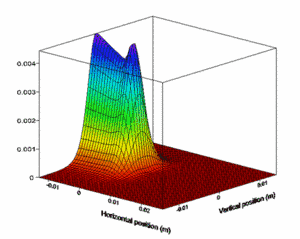Synchrotron Radiation
Monitoring of synchrotron radiation is an ideal tool for beam profile monitoring as it is completely non-destructive and linear to the beam charge over a very wide range. Its exploitation is, however, limited to high energy storage rings, or to the chicane regions of a linac.
The QUASAR Group has been investigating the CTF3 beam using synchrotron radiation from both the delay loop and the combiner ring and is now aiming at designing a detector to measure the longitudinal distribution of the LHC beams using the synchrotron light they produce as they pass through a standard dipole bending magnet and a purpose-built undulator. This requires the simulation of the generated light at different energies, heat load on monitor components, and detector optimization.

Heat load [W/mm2] on LHC BSRT extraction mirror at 7 TeV
A focus has recently been put on the two LHC Synchrotron Radiation Monitor (BSRT) systems used to characterize continuous bunch per bunch transverse and longitudinal beam distributions. Since the end of the 2011 LHC run the light extraction system, based on a retractable mirror, has suffered deformation and mechanical failure that is correlated to the increase in beam intensity. Temperature probes have associated these observations to a strong heating of the mirror support with a dependence on the longitudinal bunch length and shape, indicating the origin as electromagnetic coupling between the beam and the structure.
Ongoing studies following the observation of strong heating on the BSRT light extraction system allow characterizing the effect as RF coupling between the beam and the structure. EM simulations showed that two modified designs (one consisting in a ceramic support and another in a longer mirror) would minimize the resonance effect and consequently the heating. Further simulations and stretched wire measurements on simplified prototypes, complemented by thermomechanical simulations, will lead to the final design, needed for the LHC re-start.
Currently involved QUASARs:
Selected publications:
A. Jeff, S. Bart Pedersen, A. Boccardi, E. Bravin, A.S. Fisher, A. Guerrero Ollacarizqueta, T. Lefèvre, A. Rabiller, C. P. Welsch, 'Spatial and Temporal Beam Profiles for the LHC using Synchrotron Light', Proc. IEEE Photonics, Brussels, Belgium (2010)
A. Jeff, S. Bart Pedersen, A. Boccardi, E. Bravin, T. Lefevre, A. Rabiller, F. Roncarolo, A. Fisher, C.P. Welsch, 'Design for a Longitudinal Density Monitor for the LHC', Proc. IPAC, Kyoto, Japan
C.P. Welsch, E. Bravin, A. Dabrowski, T. Lefèvre, 'Status of the CTF3 Synchrotron Light-Monitoring-System', Proc. Beam Instrumentation Workshop, Lake Tahoe, USA (2008)
C.P. Welsch, H.H. Braun, E. Bravin, R. Corsini, S. Döbert, T. Lefèvre, F. Tecker, P. Urschütz, 'Longitudinal Beam Profile Measurements at CTF3 using a Streak Camera', Journal of Instrumentation 1 P09002 (2006), CLIC note 681 and CERN-OPEN-2006-39
C.P. Welsch, E. Bravin, T. Lefèvre, 'Layout of the long optical lines in CTF3', CTF3 note 072, CERN, Geneva (2006)